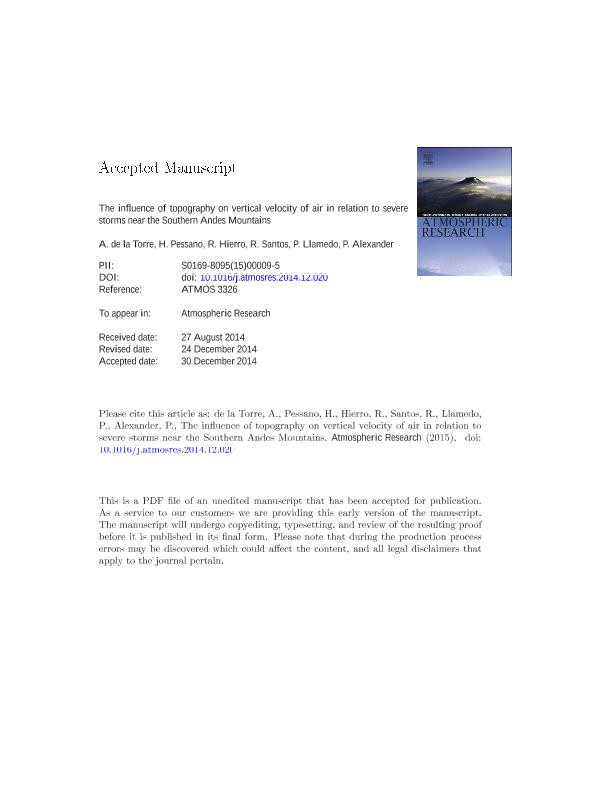Mostrar el registro sencillo del ítem
dc.contributor.author
de la Torre, Alejandro

dc.contributor.author
Pessano, H.
dc.contributor.author
Hierro, Rodrigo Federico

dc.contributor.author
Santos, J. R.
dc.contributor.author
Llamedo Soria, Pablo Martin

dc.contributor.author
Alexander, Pedro Manfredo

dc.date.available
2017-06-12T20:50:16Z
dc.date.issued
2015-04
dc.identifier.citation
de la Torre, Alejandro; Pessano, H.; Hierro, Rodrigo Federico; Santos, J. R.; Llamedo Soria, Pablo Martin; et al.; The influence of topography on vertical velocity of air in relation to severe storms near the Southern Andes Mountains; Elsevier Science; Atmospheric Research; 156; 4-2015; 91-101
dc.identifier.issn
0169-8095
dc.identifier.uri
http://hdl.handle.net/11336/18035
dc.description.abstract
On the basis of 180 storms which took place between 2004 and 2011 over the province of Mendoza (Argentina) near to the Andes Range at southern mid-latitudes, we consider those registered in the northern and central crop areas (oases). The regions affected by these storms are currently protected by an operational hail mitigation project. Differences with previously reported storms detected in the southern oasis are highlighted. Mendoza is a semiarid region situated roughly between 32S and 37S at the east of the highest Andes top. It forms a natural laboratory where different sources of gravity waves, mainly mountain waves, occur. In this work, we analyze the effects of flow over topography generating mountain waves and favoring deep convection. The joint occurrence of storms with hail production and mountain waves is determined from mesoscale numerical simulations, radar and radiosounding data. In particular, two case studies that properly represent diverse structures observed in the region are considered in detail. A continuous wavelet transform is applied to each variable and profile to detect the main oscillation modes present. Simulated temperature profiles are validated and compared with radiosounding data. Each first radar echo, time and location are determined. The necessary energy to lift a parcel to its level of free convection is tested from the Convective Available Potential Energy and Convection Inhibition. This last parameter is compared against the mountain waves' vertical kinetic energy. The time evolution and vertical structure of vertical velocity and equivalent potential temperature suggest in both cases that the detected mountain wave amplitudes are able to provide the necessary energy to lift the air parcel and trigger convection. A simple conceptual scheme linking the dynamical factors taking place before and during storm development is proposed.
dc.format
application/pdf
dc.language.iso
eng
dc.publisher
Elsevier Science

dc.rights
info:eu-repo/semantics/openAccess
dc.rights.uri
https://creativecommons.org/licenses/by-nc-nd/2.5/ar/
dc.subject
Mountain Waves
dc.subject
Storms
dc.subject
Andes
dc.subject
Mendoza
dc.subject.classification
Meteorología y Ciencias Atmosféricas

dc.subject.classification
Ciencias de la Tierra y relacionadas con el Medio Ambiente

dc.subject.classification
CIENCIAS NATURALES Y EXACTAS

dc.title
The influence of topography on vertical velocity of air in relation to severe storms near the Southern Andes Mountains
dc.type
info:eu-repo/semantics/article
dc.type
info:ar-repo/semantics/artículo
dc.type
info:eu-repo/semantics/publishedVersion
dc.date.updated
2017-06-12T18:05:57Z
dc.journal.volume
156
dc.journal.pagination
91-101
dc.journal.pais
Países Bajos

dc.journal.ciudad
Amsterdam
dc.description.fil
Fil: de la Torre, Alejandro. Universidad Austral. Facultad de Ingeniería; Argentina. Consejo Nacional de Investigaciones Científicas y Técnicas; Argentina
dc.description.fil
Fil: Pessano, H.. Universidad Tecnologica Nacional. Facultad Regional San Rafael; Argentina
dc.description.fil
Fil: Hierro, Rodrigo Federico. Universidad Austral. Facultad de Ingeniería; Argentina. Consejo Nacional de Investigaciones Científicas y Técnicas; Argentina
dc.description.fil
Fil: Santos, J. R.. Universidad Nacional de Cuyo. Facultad de Ciencias Exactas y Naturales; Argentina
dc.description.fil
Fil: Llamedo Soria, Pablo Martin. Universidad Austral. Facultad de Ingeniería; Argentina. Consejo Nacional de Investigaciones Científicas y Técnicas; Argentina
dc.description.fil
Fil: Alexander, Pedro Manfredo. Universidad de Buenos Aires. Facultad de Ciencias Exactas y Naturales. Departamento de Física; Argentina. Consejo Nacional de Investigaciones Científicas y Técnicas; Argentina
dc.journal.title
Atmospheric Research

dc.relation.alternativeid
info:eu-repo/semantics/altIdentifier/doi/http://dx.doi.org/10.1016/j.atmosres.2014.12.020
dc.relation.alternativeid
info:eu-repo/semantics/altIdentifier/url/http://www.sciencedirect.com/science/article/pii/S0169809515000095?via%3Dihub
Archivos asociados
